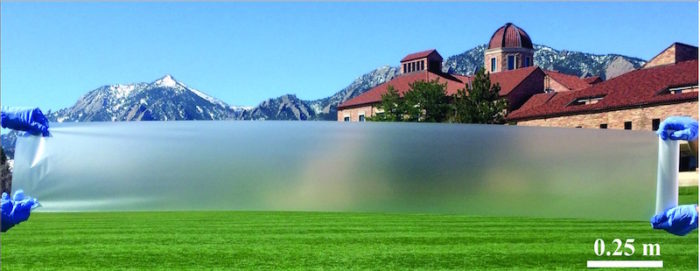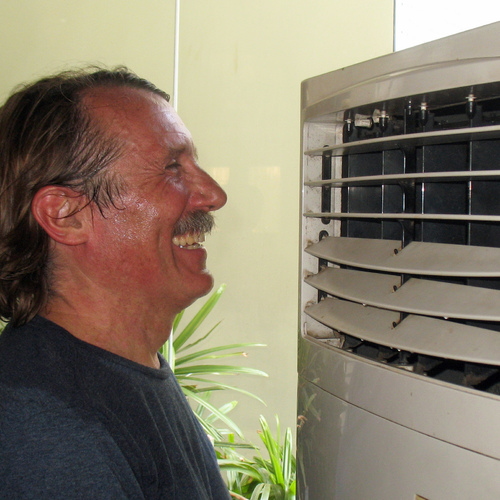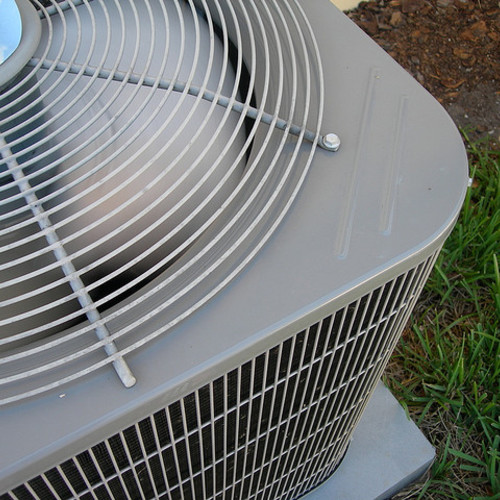
Image Credit: University of Colorado at Boulder
When it’s hot out, we want cold. At night, we like to be able to turn on the lights. During the daytime, it can be hard to find the darkness.
All these things — hot and cold, day and night, light and dark — can seem like opposites. Chinese philosophy suggests, however, that these opposing forces, known collectively as the yin and the yang, aren’t separate. And science has proved it. Let me tell you about the latest yin and yang science and how it could revolutionize air conditioning.
Willis Carrier’s air conditioner
For a hundred years we’ve been using these mechanical systems called air conditioners to remove heat and humidity from buildings. It was one of many revolutionary technologies to come out of the twentieth century. Because of air conditioning, places like Orlando and Phoenix have far higher populations than they probably would otherwise.
An air conditioner works by cycling the indoor air through a box that contains a fan to move the air and a cold coil to cool and dehumidify the air. It pulls in air from the home, sends it over the cold coil, and then sends that cooler, drier air back into the house. Wonderful!
But what happens to the heat? The heat from the indoor air goes into that cold coil. The coil is filled with a refrigerant, a material that can get cold. After it absorbs the indoor heat, the refrigerant travels to the outdoor unit (in a typical split system). The outdoor unit uses a compressor and another coil to dump the heat into the outdoor air. Yes, other types of air conditioners exist, but the vast majority are of the type I just described: split-system, air-source air conditioners. (For more detail on how they work, see my article, The Magic of Cold.)
The compressor is the the big energy hog in an air conditioner. It creates a high pressure and circulates the refrigerant. Compressors have gotten better over the years, but the process is still energy-intensive.
The power of radiative cooling
Every bit of matter radiates energy away to its surroundings. Matter also absorbs energy from its surroundings. Whether the net energy flow is into or out of a particular object depends on two factors: temperature and emissivity. The Stefan-Boltzmann Law in physics puts all this together.
We’ve discussed this before. I stated it a bit differently then, using as an example a naked person jumping on a bed. (Perhaps you recall my article Naked People Need Building Science?) The surface temperature of his body is higher than the surroundings, especially the single-pane window. Thus, the net flow of heat is out his naked body and into the surroundings.
Back in the 1970s, when the energy crises spurred lots of energy innovation, radiative cooling was one of the ways people tried to save energy. In the solar energy class I took in grad school, I learned about one method that required a pool of water on the roof. The water was thermally connected to the indoors during the day while being covered and insulated from direct solar gain and ambient heat. At night, the cover came off and the water could radiate the heat it picked up from inside the house during the day and send it out to the cold night sky.
Nice idea, if you don’t mind having all that water overhead. But it was limited by being able to get rid of that heat only at night. So we have a day and night problem. Light and dark. But how do we get to the yin and yang?
A metamaterial film that provides free cooling*
The peer-reviewed journal Science has an article with a convoluted title, Scalable-manufactured randomized glass-polymer hybrid metamaterial for daytime radiative cooling, but a simple message. The researchers have developed a material that can radiate heat away at night and during the daytime. And it does so with an impressive capacity.
The photo at the top of the article shows the material, a translucent film. It’s basically a plastic film with tiny silicon dioxide spheres embedded in it. (Silicon dioxide is the main component of a lot of the world’s sand.) The spheres play a critical role in tuning the material to emit infrared radiation while not absorbing any of solar radiation that hits the material during the daytime. The paper goes into the the physics, including a discussion of phonon-enhanced Fröhlich resonances of the microspheres and extinction cross-sections, but I’ll let you read you that those details if you choose.
The film and microspheres, together called a metamaterial, make up one part. It doesn’t absorb solar radiation, instead letting those electromagnetic waves pass right through. So they put a reflective backing on the film to reflect the sunlight back out. That prevents it from heating up whatever is behind the film (which would be a building in our case).
What could turn out to be a really exciting discovery for the building community is their measured cooling capacity. They set up the film outdoors and measured how much heat it could radiate to the open sky. They used an electric heater to pump heat into the film and adjusted the rate to keep the film at the same temperature as the surrounding air. By adding just enough heat to keep the temperatures equal, the researchers say the “total radiative cooling power is therefore the same as the heating power generated by the electric heater.”
They did this experiment in Cave Creek, Arizona, in autumn. The solar irradiance at noon was more than 289 BTU/hr per square foot (900 W per square meter). Over three days, they found the cooling capacity to be:
- 29.5 BTU/hr per square foot (93 Watts per square meter) at noon
- 34.9 BTU/hr per square foot (110 W per square meter) over 3 days
That’s pretty amazing. What it means is that you could get a ton of cooling capacity (12,000 BTU per hour) with about 400 square feet of this film. A typical new house these days has a cooling load of about one ton per 1,000 square feet of conditioned floor area. It shouldn’t be hard to find enough roof area to get all your cooling needs met if this material turns out to be as good as it looks now.
About that asterisk…
Yes, the title of my last section is correct. The film itself does provide cooling with no energy input. But to cool a building, you’ll definitely need to use some energy. Otherwise, you won’t be able to get the heat in the building to the film on the roof. One good way to do this would be to use hydronic panels to pick up heat inside the house and circulate it up to where the film is on the roof.
So it’s not a free lunch. Sorry.
What’s new here?
Other researchers have looked at similar methods of radiative cooling. (See this article, for example.) What seems to be different here is that the previous materials were difficult to make and expensive to scale up. This one is a plastic film with embedded microspheres. It should be much easier and cheaper to produce. Hence the first word of their title: scalable.
Yes, there are still a lot of questions. They did this work in a dry climate. What happens when you put that film on a roof in a humid climate? How well do they work on cloudy days?
Will this metamaterial eventually replace traditional air conditioners? I think it holds a lot of promise, but it remains to be seen what happens. The best technology, even after being fully developed, doesn’t always win in the marketplace. (Remember VHS versus Beta?)
One thing we do know, though, is that those Chinese philosophers had a lot of insight. So, too, do the University of Colorado researchers who led this study. Their names are Yin and Yang. Really!
Thanks to Lloyd Alter for bringing this article to my attention. You can read his article about it on Treehugger: New plastic wrap might keep buildings cool even when the sun is shining.
Allison Bailes of Decatur, Georgia, is a speaker, writer, building science consultant, and the author of the Energy Vanguard Blog. You can follow him on Twitter at @EnergyVanguard.
Weekly Newsletter
Get building science and energy efficiency advice, plus special offers, in your inbox.















One Comment
I'd rather have the reverse
The similar concepts I've seen before attempt to do the reverse: block solar radiation, ideally by reflecting it, and transmit thermal radiation. Then you can have a surface beneath the film radiating to the sky while being protecting from incoming heat, including incoming solar radiation, and incoming convection from the outdoors. That allows cooling to below ambient temperature.
On the other hand, the way they tested this film, by keeping it at a temperature equal to the air temperature, illustrates that it would be difficult to use it to cool anything below ambient temperature.
Log in or create an account to post a comment.
Sign up Log in